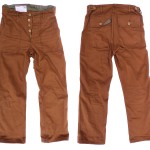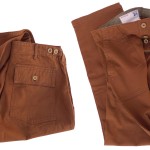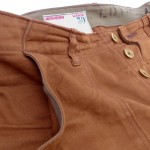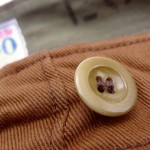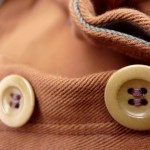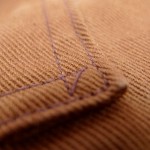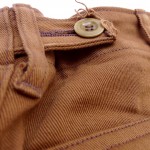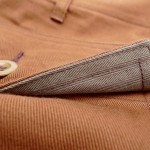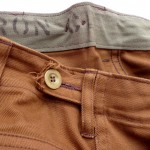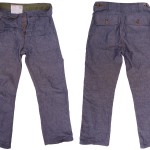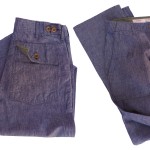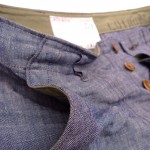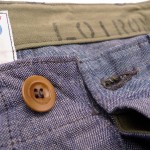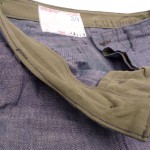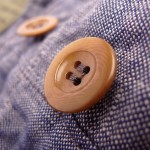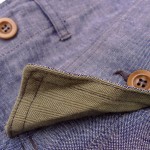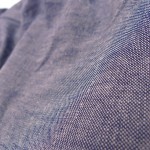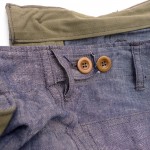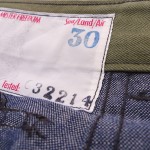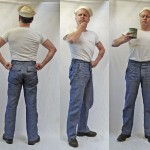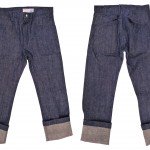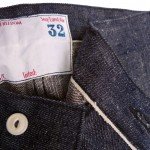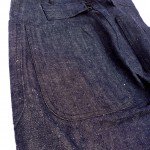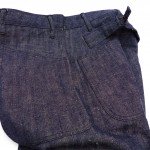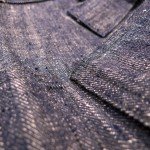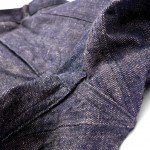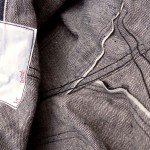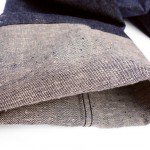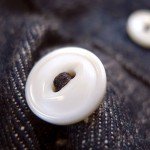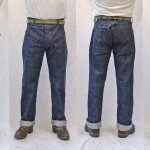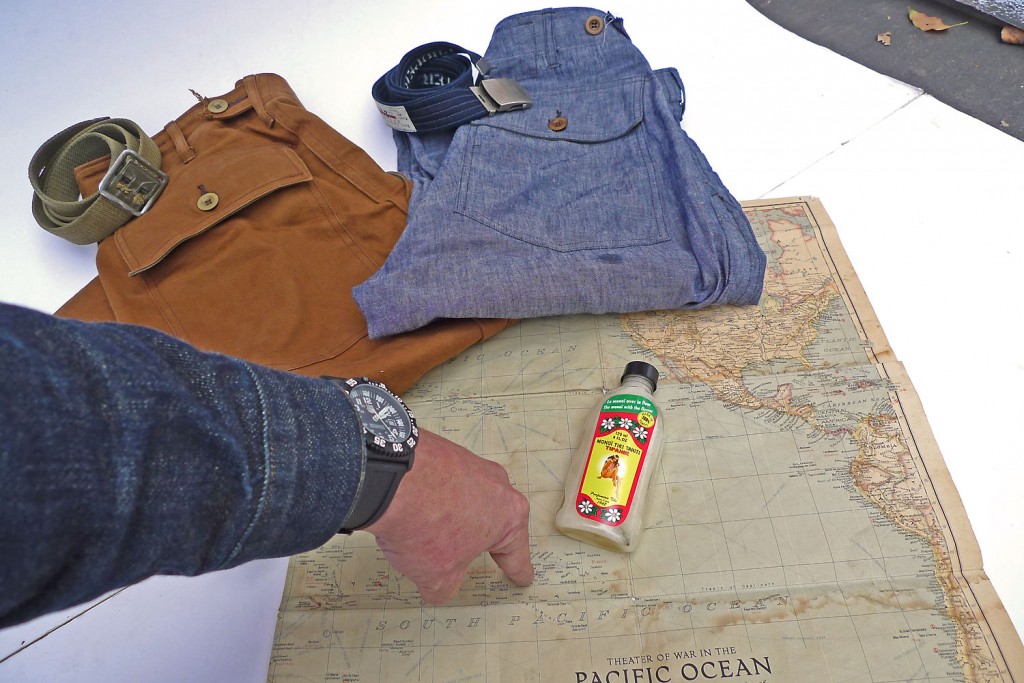 Right there.
Yes! Right there…
Shooting the ‘Crew Pants’ in the back of the store for this next “Sea Hunt” post the other day, I looked closer at one of the props. Namely a Feb. 1942 issued map of the Pacific Ocean, found inside a 40’s white USN ditty bag, along with the sailor’s stencils/cover/letters…
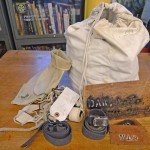 Daw, T.A.’s USN Ditty Bag On the map, he had circled his way from Newark to Portland to… the Solomon Islands (Guadalcanal ’42, anyone?)
Not sure what happened to seaman “Daw, T.A.”, but what he did then gives me the liberty today to choose another destination.
I pick Bora Bora. So I’m adding my longtime favorite body oil as an extra prop to the photo. Made in Tahiti since 1942. Get sum’ here!
🙂
Sooo, dear Monsieur Monoi and Madame Tiki, kindly mail two complimentary airline tickets to:
Mister Freedom®, 7161 Beverly Blvd., Los Angeles, CA 90036,USA.
Māuruuru in advance 😉
Anyways…
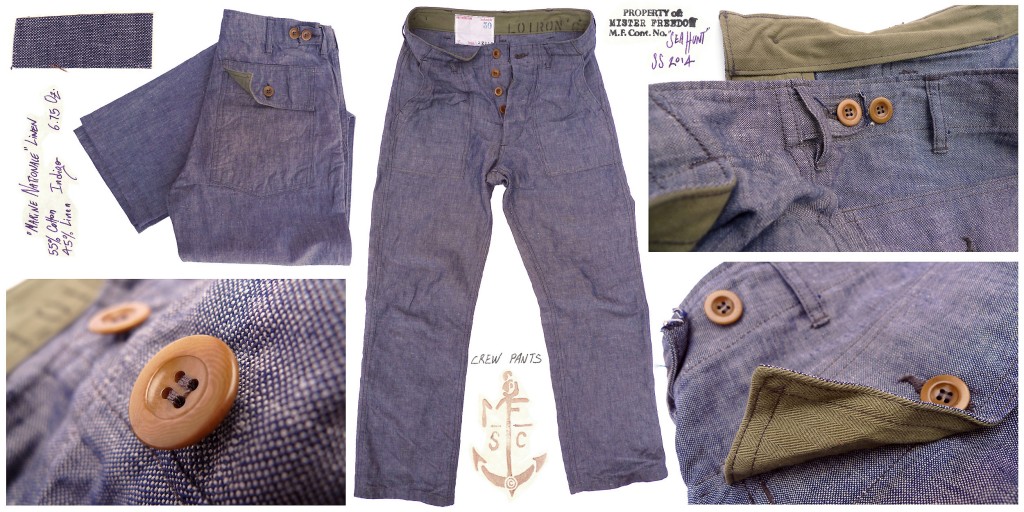
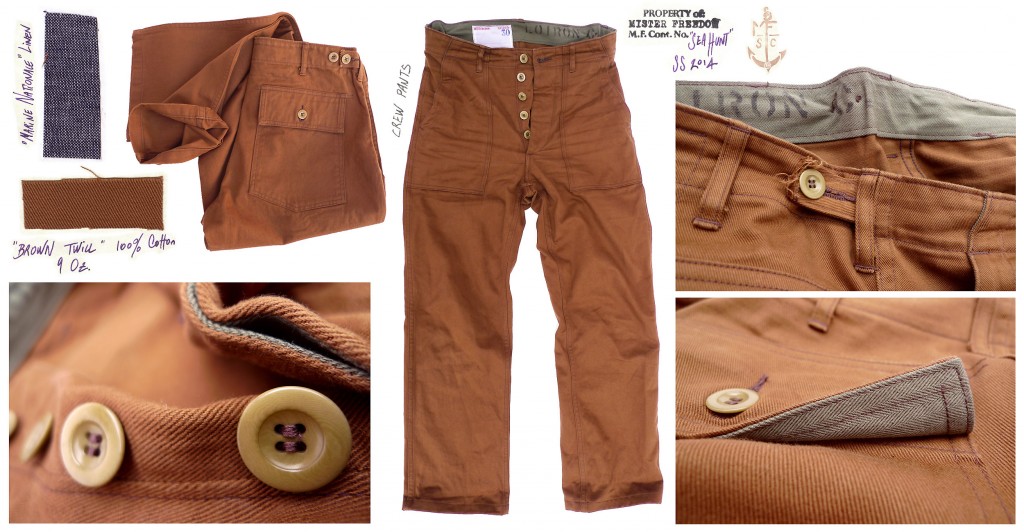
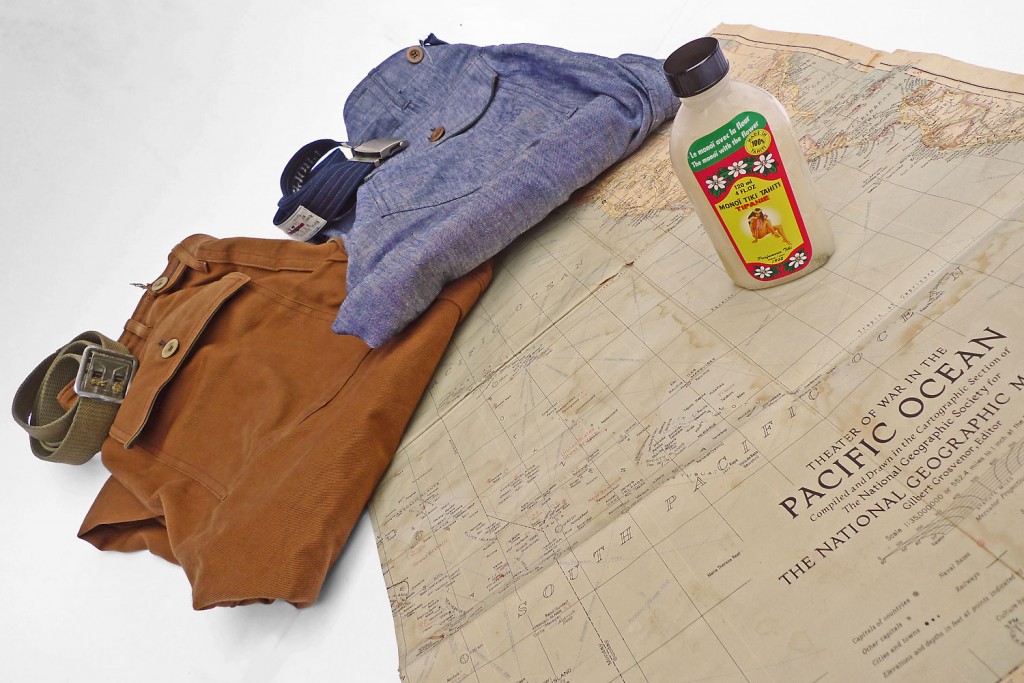
Mister Freedom® “Crew Pants”
‘Sea Hunt’ mfsc Spring 2014
Commonly referred to as ‘fatigues’, the US Army “Utility, Trousers, OG-107, TYPE 1 Class 1” became associated with the early years of the Vietnam conflict. The original 8.5 Oz fabric they were made of was a type of carded cotton sateen vat-dyed Olive Green, shade number 107. This sturdy fabric was well adapted for Korea, but was later found unsuitable for a tropical jungle theater and replaced by popeline and ripstop for the utility sets.
Some call these trousers ‘Baker Pants’. According to Artist and collector Patrick ‘Riveted’ Segui, this might refer to the fame of US Army MSgt. John Franklin Baker, Jr., Medal of Honor decorated ‘tunnel rat’ hero of the Vietnam war. Anyone with an alternate explanations for the term is welcome to pitch in. Anyone wanting to correct me on other historical inaccuracies I might have committed is truly welcome too.
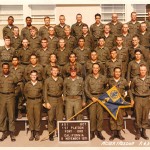 Business in the front… 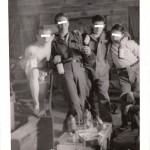 … party in the back. NOTE: Both above images from our archives are NOT related, were taken some twenty years apart and are NOT intended to be disrespectful in any way.
The Mister Freedom® ‘CREW PANTS’ share the general pattern of these P57 (pattern dated 11 March 1957) ‘fatigues’, including the waist adjuster tabs and large rear pocket flaps of type 1 trousers.
Where we decided to intervene and wake up from lethargy however is with the choice of fabrics. The idea was to mix things up, continents, eras, fabrics and styles, as the members of our Team did when giving instructions to have their custom functional gear designed. These trousers soon became everyone’s favorite, on and off board.
Here are the two options for our version of these classic utility trousers:
a) “MN” Linen-cotton:
Referring (again) to the French Navy, this 6.75 Oz blend of 55% cotton and 45% linen was developed from several 1950’s vintage samples of French Marine Nationale utility uniforms. The fabric is similar to a thick type of slubby chambray, rendered ‘crispy’ by the linen content. Our version features actual indigo dyed yarn, as was used in very early models. I have always loved this fabric, the color, the feel and the way it fades overtime.
For decades, a French seaman’s ‘tenue de travail’ partly consisted of buttoned flap-front deck pants, pleated summer shorts, pull-over tops (vareuse) and a (rare) shawl collar jacket made out of this fabric. It was replaced by a purple-ish color denim-like cotton twill in the 1970’s, subsequently evolving into a poly-cotton version.
We sent several vintage samples and instructions to the fabric experts at Toyo Enterprises, and we were honestly thrilled with how nice the resulting Japan milled textile came out.
I have always longed to find a pair of ‘simple’ trousers in that cotton-linen fabric that would be easier to wear than the typical crackerjack style pants. There is it 😉
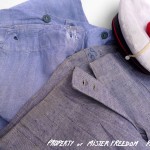 Vintage 1950’s French Navy inspiration b) Brown Twill:
This 9 Oz 100% cotton fabric was developed from a WW1 US Army officer pair of jodhpurs from our archives. I really loved the feel of the twill and the way it had evolved though the years. That vintage fabric was totally different from the more common army chino twill we are used to.
Again, the textile experts at Toyo Enterprises were put to the challenge with that mystery, studied yarn per yarn, and milled the fabric according to a tiny swatch hidden in a seam, tightly protected from wear and sun exposure. These guys use microscopes and crazy technical fabric content tests. They’re good.
Interestingly, the resulting original pre-fade color is very similar to that of our Britches Chaparral and Americano Trousers. The common thread…
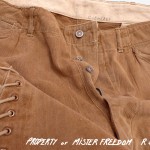 Vintage WW1 US Army jodhpurs inspiration. For both options, we are using an Olive Drab USMC HBT fabric (courtesy of Buzz Rickson’s) for the waist band lining and fly facing, a WW2 OD shade #7. Please note that production does not come with someone’s name stenciled on the inside waistband. I have a tendency to mark most of my clothes, for no other reason than an old tenacious habit from bygone boarding school days.
The “CREW PANTS” of our Sea Hunt Spring 2014 Collection are made in Japan as a collaboration between Mister Freedom® and Sugarcane Co.
SPECS:
FABRIC: Two fabric options
a) “MN” Linen-cotton: 6.75 Oz blend of 55% cotton and 45% linen, plain weave. Milled in Japan exclusively for mfsc.
b) Brown Twill: 9 Oz 100% cotton twill fabric (approx. color Pantone Reference: 732 U)
DETAILS:
* Pattern adapted from an original pair of US Army P57 utility trousers.
* High-waist, straight leg, generous fit.
* Two ply waistband with Olive Drab USMC HBT fabric lining (OD shade #7)
* Button fly, corozo (vegetable ivory nut) top and fly buttons.
* Side waist adjuster.
* Flat felled seam construction for seat and inseam.
* 100% cotton tonal stitching.
* mfsc white woven label, ready for perso markings.
SIZING/WASHING:
Both fabric options come un-washed, as always with MF® gear.
Although different in measurements when raw, both will shrink to a very similar fit. Due to the different drape of the two very different fabrics, the same size might however feel and appear different when worn.
The Brown Twill are cut longer than their MN linen counterpart, for no other reason than to make us all wonder why…
Please note that due to the ‘crispiness’ and wrinkling properties of linen, leg creases will ‘lift’ the fabric and will have to be put into consideration for those hemming their pair.
I had to size down to a Waist 30 on both of these CREW PANTS, which I right away attributed to my daily 3mn planking routine I started last week. Nice try. They ARE cut quite generously.
We recommend the usual original cold soak/spin dry/line dry routine.
Please note that our rinse tests were done following this method, and that using hot water and powered dryer (both not recommended) will result in more shrinkage.
Further washing, when needed, should be done on ‘delicate’, with mild detergent, and trousers turned inside out to avoid ‘marbling’ of the fabric.
After a few cycle of normal wash/wear, the CREW PANTS will reach their low-maintenance status and age gracefully.
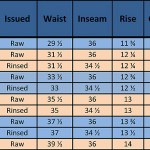 MN Crew Pants 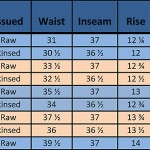 Brown Twill Crew Pants
Available Raw (unwashed) ONLY
Tagged Sizes
W28
W30
W32
W34
W36
W38
Retail $439.95
Available from our brick & mortar and our webstore.
Please call the store at 323-653-2014 or email sales@misterfreedom.com with questions not addressed above.
Thank you sincerely for your support 🙂
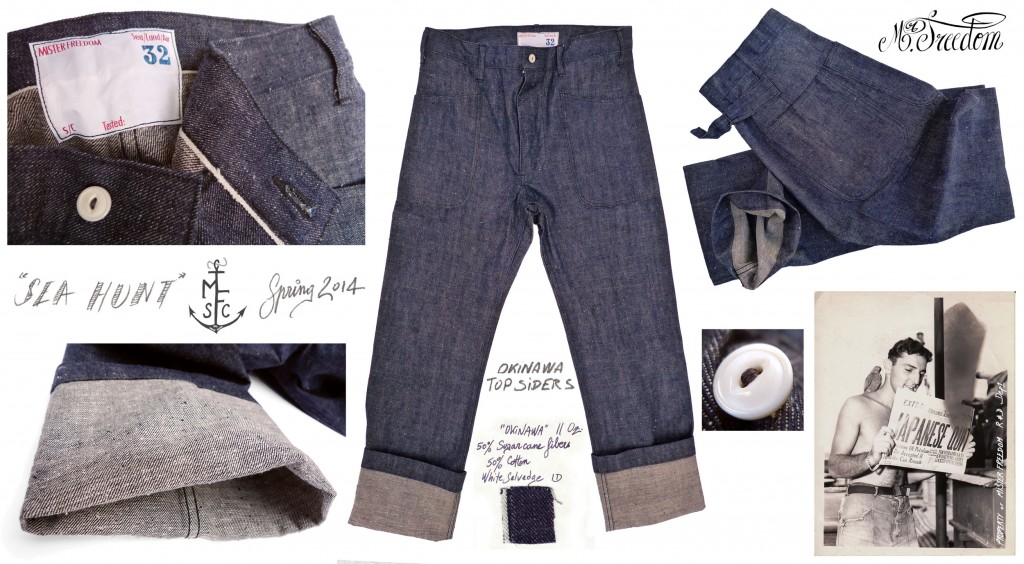
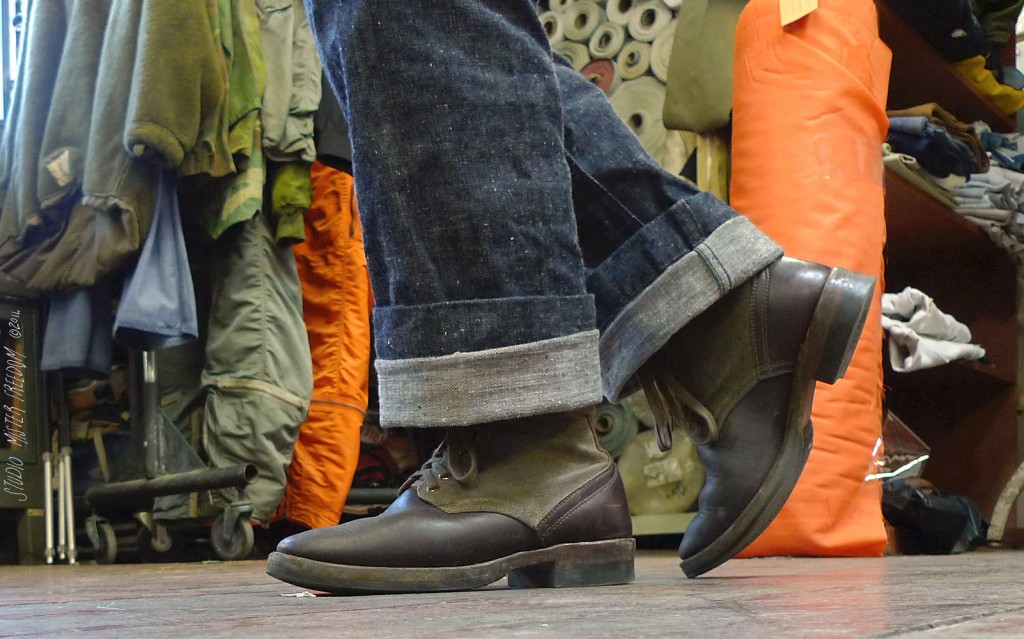
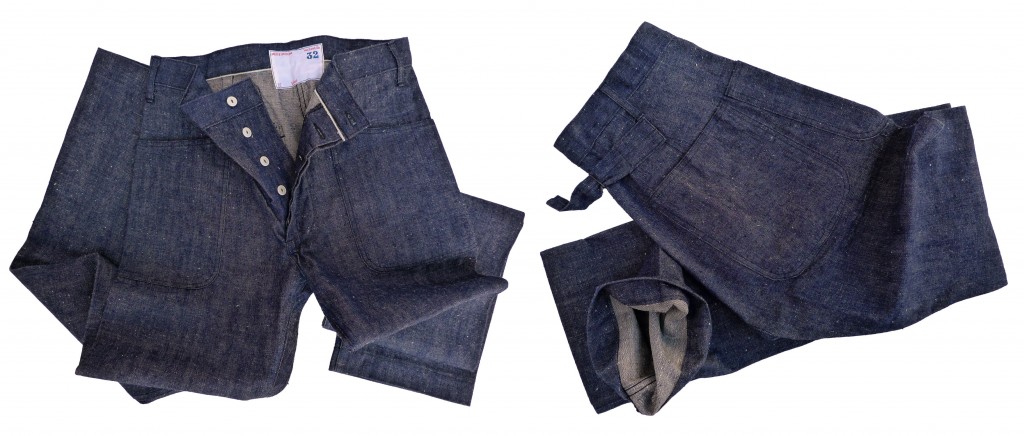
Mister Freedom® Okinawa Topsiders, sugarcane fiber denim
‘Sea Hunt‘ mfsc Spring 2014
The idea was brought to the drafting table by one member of the Team, a retired Navy snipe. The beat-up denim work pants that had accompanied him in his early years at sea turned into the basic pattern of the mfsc “Topsiders”…
-o-o-o-o-o-
Denim often goes in pair with imagery of US Navy ships at sea during WW2.
Anchored in popular culture by Hollywood, immortalized in such great movies as “The Sand Pebbles“, the below-and-above-deck sailor getups meant denim and chambray. Never to be worn off-base or off-ship, work outfits of enlisted personnel consisted of denim dungarees matched with a choice of chambray shirt, white skivvy or non-regulation sunburned skin. The expertly shaped “Dixie Cup” topped that familiar swabbie silhouette.
Spare sets of work clothes were often privately purchased, according to one’s chores. As a result, period photos often display an eclectic mix of regulation and non-regulation dungarees, including seafarer-type flares in the 1930’s… Same drill with chambray shirts, as non regulation chin straps and pocket flaps are sometimes spotted on early shots.
For further reading on WW2 USN dungarees head over to this RIVETED blog post by artist Patrick Segui.
(All below photos from MF® private photo archives, gathered from several photo albums.)
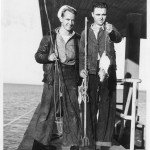 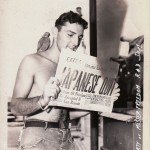 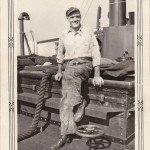 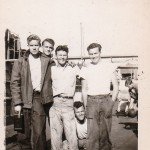 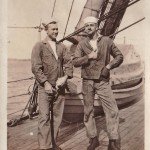 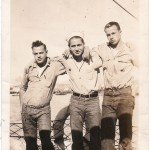 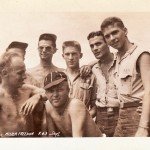 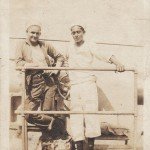
Although personnel in the Army was also issued sets of denim work clothes (such as M1937 shirt and trousers, M1940 chore jacket), these didn’t ‘make the cut’, as they were replaced by Olive Drab Herringbone Twill field uniforms, in 1941. This assured OD HBT its place in the limelight, a center stage spot in the fabrics of heroes.
For both 1940’s US Marines and Army personnel, HBT became the field fabric, while blue denim stuck to sailors of the US Navy.
Photos below are US Army pre-HBT days, 1937~39 according to album personal notes.
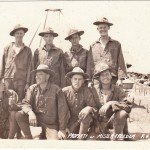 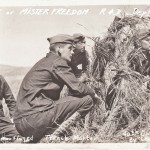 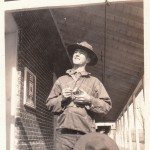 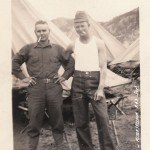
-o-o-o-o-o-
An original pair of vintage 1940’s wrap-leg US Navy issued dungarees has somewhat of an ‘awkward’ fit: very snug waist, no hips, uncommonly high-rise and very wide straight leg. I have to admit that I quite like that silhouette on old photos, albeit challenging by today’s standards for some.
However heavily inspired by an original pair of USN wrap-leg dungarees, our “Okinawa Topsiders” feature an adapted cut. Yes, we decided to make it even more ill-fitting than an original. Mission accomplished. They now have a mid-rise, similar to the rise of our Californian blue jeans. Please note that this lower rise might not work for some who are partial to traditional authentic high-waisted sailor trousers…
We also added the old cinch-back strap for good measure.
Because of the one piece wrap leg construction, it would appear that no selvedge would be showing? Have no fear, it is inconspicuously displayed twice! First in the waist band and then in the crotch gusset. Yes Sir, and here is why:
We opted for one of our long-time favorite denim fabric, the “Okinawa” indigo selvedge left-hand twill SC401 denim, a blend of 50% cotton and 50% sugar cane fibers patented by Sugar Cane Co. The width of this shuttle-loom-milled textile is about 29 inches. This is not wide enough for an entire wrapped leg. Therefore, an extra piece of denim fabric had to be spliced in order to ‘finish’ the leg. This is where the selvedge appears, concealed at the crotch.
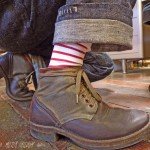 Look Ma… no red lines! Like the vintage original from our archives, our “Topsiders” feature four patch pockets, the front ones judiciously positioned to discourage Parisian metro pickpockets. We did managed to make them a bit more accessible than the wrap pockets on our original “7161 Utility Trousers” from 2007, so no need to take your pants off to retrieve loose change. The back pockets are positioned low and are quite deep.
To give our Topsiders a flair of USN undress whites, we chose off-white corozo (aka vegetable ivory) buttons, top and fly.
Labeling:
Our “Sea Hunt” label this season is a nod to vintage European military/utilitarian type labels, with more space left out to fill with custom marking than the usual boasting about ‘Best this/Greatest that’. This ties in with the concept behind this 2014 Collection, where each garment was issued for a specific mission. One would log-in date/location/name and other relevant info with a marking device directly on the white label…
The “Okinawa Topsiders” are made in Japan as a collaboration between Mister Freedom® and Sugarcane Co.
SPECS:
FABRIC: “Okinawa” SC401, unsanforized 10 Oz. left-hand twill indigo denim, 50% cotton 50% sugar cane fibers, solid white Selvedge ID, milled in Japan.
DETAILS:
* Pattern adapted from an original pair of WW2 US Navy denim dungarees.
* Roomy straight leg.
* Wrap-leg construction, no side seams.
* Button fly, white corozo (vegetable ivory nut) top and fly buttons.
* Selvedge waistband.
* Selvedge ‘crotch gusset’.
* Two functioning rounded bottom front patch pockets, two deep rounded bottom rear back pockets.
* Adjustable back cinch strap.
* Skinny belt-loops for 2” wide belts
* Flat felled seam construction for seat and inseam.
* 100% cotton black stitching.
* Customizable mfsc white woven label.
SIZING/WASHING:
The Topsiders come RAW (unwashed) and will pretty much shrink to tagged size.
We recommend an original cold soak of about 20mn, machine spin dry or drip dry, line dry. We don’t recommend heat dryers.
Further washing should be limited to when required by common sense, as in when your jeans are dirty, which obviously greatly fluctuates according to one’s occupation.
It is a good idea to wash denim inside-out when comes bath time, to avoid marbling.
The cut of the Topsiders is pretty generous in the leg and in the waist. It is the nature of the Okinawa denim to shrink and stretch back and forth with each rinse/dry/wear cycle. This eventually settles, but two pairs of waist-32 might end up fitting differently according to the wearer’s build and activities.
The 1½ inch fold of the bottom hem uses a simple single-needle machine stitch. Across the board, the length shrinks to an approximate 34 inches.
I wear a comfortable waist 32 in the Topsiders, with room for the entire family.
I do not recommend sizing down for a slimmer silhouette, as this would result in making the rise appear slightly too low, in my opinion.
Please refer to sizing chart for raw and rinsed measurements. Please note that our rinsed measurements (cold soak/line dry) show minimal shrinkage. Using hot water/power dryer (both NOT recommended) will result in more shrinkage.
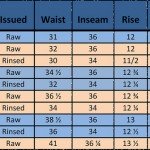
Available Raw (unwashed) ONLY
Tagged Sizes
W28 × L36
W30 × L36
W32 × L36
W34 × L36
W36 × L36
W38 × L36
Retail $439.95
Available soon from www.misterfreedom.com
Please call the store at 323-653-2014 or email sales@misterfreedom.com with any questions not addressed above.
Thank you sincerely for your support
🙂
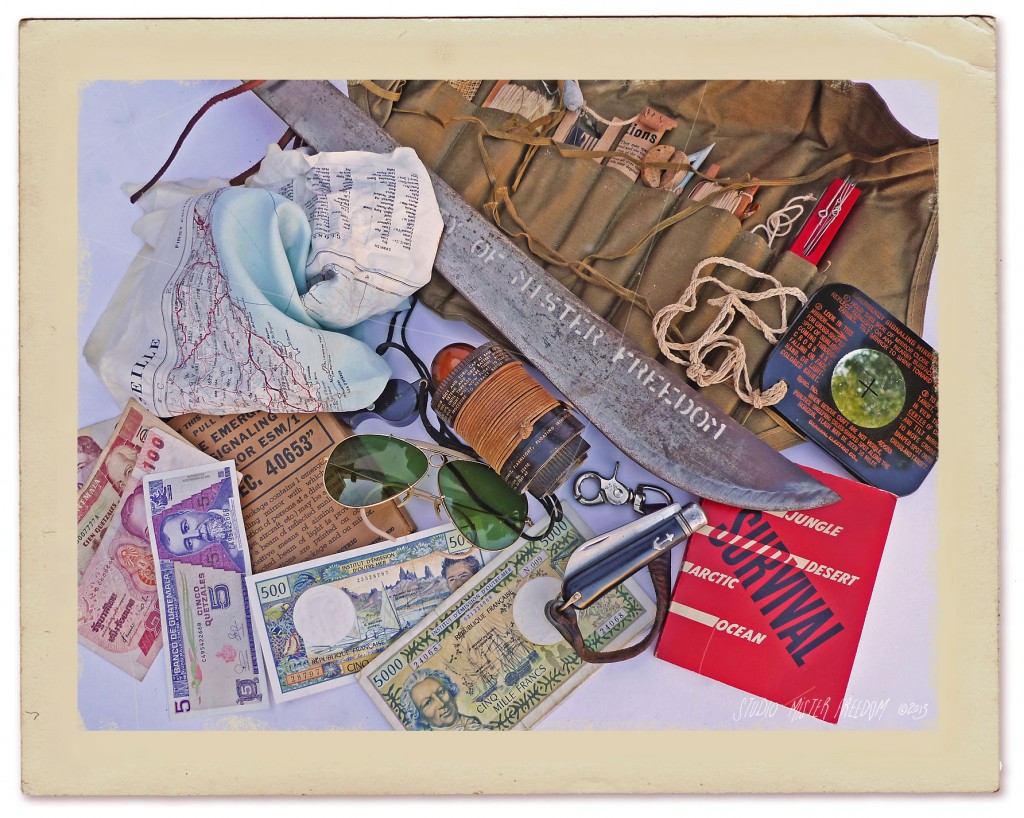

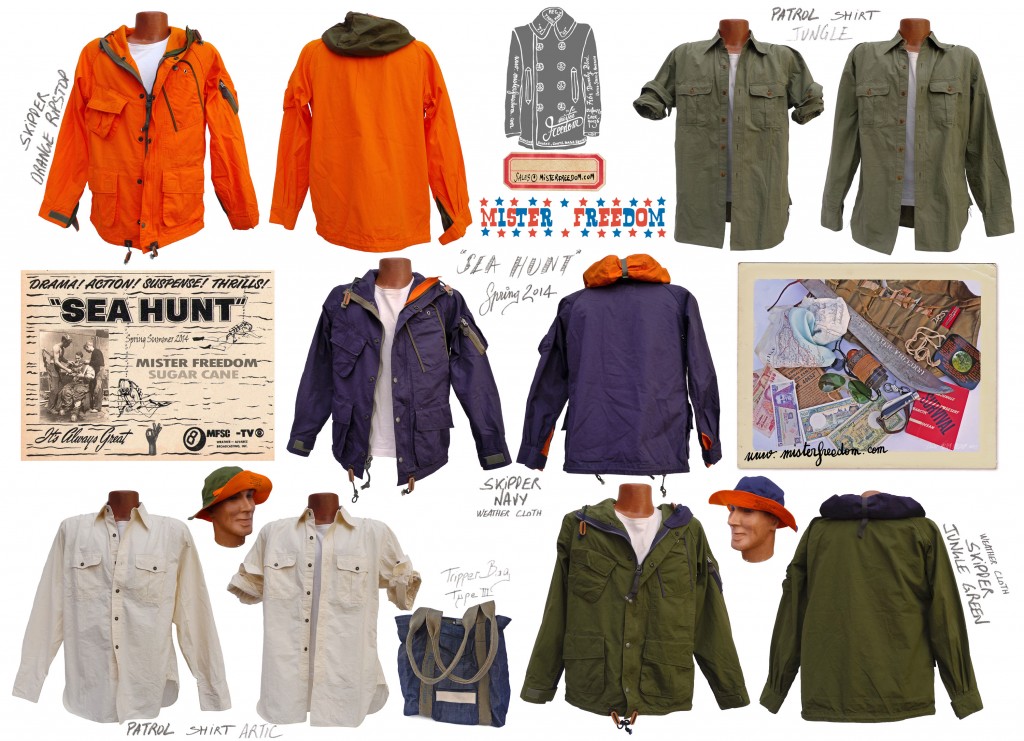

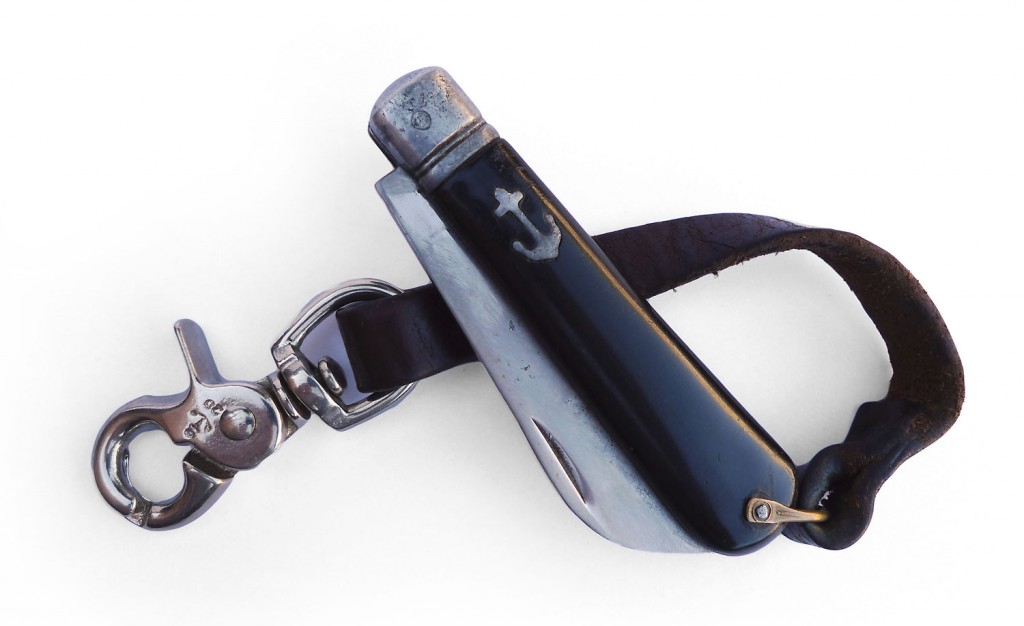
MFSC “SEA HUNT”
Mister Freedom® x Sugar Cane Spring 2014 Collection
Digging through an old box of personal photos kicked a bit of nostalgia dust last year.
There was a time when one didn’t document every minute of daily life with 16 photos per second, so i am very much attached to the few hard copy prints that survived my youth. In one envelop were some mid 1980’s traces of a period of my life that seems to be someone else’s…
I had done some time aboard an old rusty ship of the “Marine Nationale“, up and down the Indian Ocean, around 1985. For the French, Military Service was mandatory until 1996. Should you opt for the Navy, serving consisted of a 12 month course in evading-chores-by-looking-busy’, punctuated by sleep deprivation for those at sea.
At the end of my 1 1/2 year (I piled up since I had nothing better to do), I got skilled at both and was ready for a life of, I envisioned, leisure.
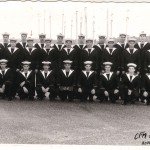 Naval training school. Hourtin, France, 1986 During my tour, blessed were we all by the relative absence of major wars at the time, my ship’s duty included hunting down illegal fishing boats, the likes of which we never actually encountered. Comorian fishermen had obviously been using submarines.
Nonetheless, participating in geopolitical presence in waters known as TAAF (Territoire des Terres Australes et Antartiques Francaises) was great for a 20 year old. I don’t regret any minute of that paid vacation and its many discoveries and lessons.
Having sworn to secrecy under my Confidentiel-Défense status at the time (my specialty was transmission ie. decoding and relaying messages that were way above my head, sent through hi-tech technology that involved a large noisy machine spilling out punched paper tape…), there are obviously things i cannot talk about here. Such as the following, for instance:
* My Lieutenant kicking my sleepy rear to attention around 0500 (pronounce zero-five-hundred for effect, thank you), as i laid motionless on a Mayotte (I think) sun-bleached wooden pontoon (I know). That EV1 had awoken a few minutes before me, a few yards away. We, along with a few of the ship’s finest on that pontoon, had missed the shuttle deadline back to the ship the night before. I have somewhat of a blurry remembrance of that debacle, but I am pretty positive it didn’t involve g Earl Grey and museums. Whatever classy local establishments were honored by our presence that evening have been eradicated from memory. What I, and an agitated taxi driver surely do remember however, is the moment i noticed my wallet was gone…
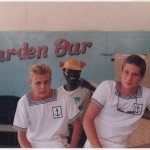 Another classy establishment, with my good buddy ‘Tug’, and an unidentified happy gentleman. Kenya 1987 * On another ‘critical mission’, we moored next to a very tiny remote Indian Ocean island called Juan de Nova. The island was inhabited by a group of intimidating sun-beaten French Paratroopers stationed there. I believe that mission was called: “Hey guys, we were nowhere in the neighborhood, so we decided to stop by”. These Special Forces bunch hadn’t seen much else than each others’ mugs for a while, appeared quite content with it, and used words like they were rationed. Conversing with a yellow-haired skinny squid was not on their priority list.
As a lucky member of the shore party, the emotional equivalent of winning the Lottery, I took a solitary stroll around that island. I was trying to look at it from a Crusoe perspective, immersing in the concept of ‘trapped in Paradise’. As postcard pretty as that island was, I came to the conclusion that I wasn’t just ripe for marooning. Today, I might reconsider.
These dudes and that island however, left quite an impression on me. I knew they had some stories. If that island could talk…
 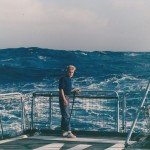 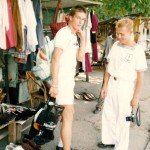 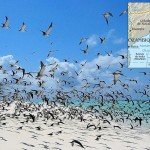 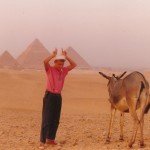
Some 30 years later, trying to piece a somewhat coherent story for a new concept, many of these snapshots and memories helped me come up with a brief script, the backdrop of Mister Freedom® mfsc Spring 2014.
This collection might seem to some as a 360º + 90º turn compared to previous MF® line-ups.
I have to admit I was done with the 1900’s, sepia, dark alleys, gangs, smoky gambling saloons, battlefields, the Dust Bowl, revolutions… All good stuff but doing research can be draining, and I wanted a break from chaotic situations. The constant visualization of violence-charged images is a bit disturbing over time.
I longed for Cousteau’s exploits. On COLOR TV!
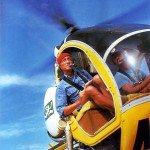 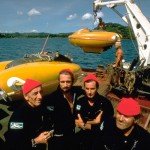
I realized I was craving for a shot of sun-drenched islands, turquoise lagoons, luxuriant vegetation, adventure, coastal surveying, successful survival stories, tropical scientific journeys and treasure hunting! I wanted the fascinating mental escape that the lure of hidden mysteries brings. I needed the high of discovering and learning something new. Maybe I wanted to play GI Joe again, sans war…
Over the summer of 2013, I religiously listened to a radio show podcast on France-Inter called “Le Temps d’un Bivouac“, highlighting the works of contemporary adventurers, scientists, nomadic philosophers, field writers, anthropologists… Fascinating interviews that turned my commute to work into a blissful moment.
Also, along with watching several documentaries about discoveries and expeditions, some fascinating reads kept me in the mood for this collection (I have become an audible addict):
* “South Sea Tales” by Jack London.
* “River of Doubts” by Candice Millard.
* “Deep Survival” by Laurence Gonzales.
* “Shadow Divers” by Robert Kurson.
* “The Lost City of Z” by David Grann.
* “Into Africa” by Martin Dugard.
* “Au Congo Jusqu’au Cou” by Patrice Franceschi
* “Between Man and Beast” by Monte Reel.
* “Unbroken” by Laura Hillenbrand.
* “Wolf, The Lives of Jack London” by James Haley.
* “The Things They Carry” by Tim O’Brien.
…
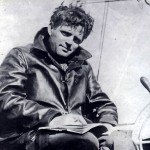 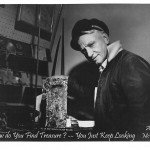 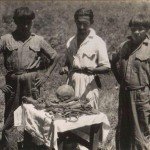 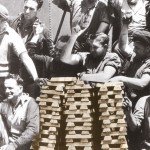 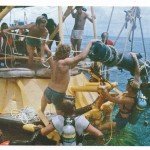 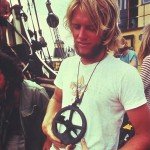 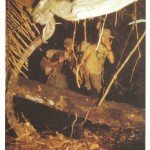
So, here she goes…
The mfsc “SEA HUNT” Story
“And there were these guys I ran into a while back at the Harbor Inn. They called it the Horrible Inn…
A rugged bunch of fun-loving and thrill-seeking daredevils who combed the Earth for adventure, the unanswered, and the occasional gold that crept from under their feet.
From attempts at locating Percy Fawcett’s “City of Z” in the Amazon, to ID-ing obscure sunken U-boats off the New Jersey coast, from privately funded rescue missions of some fortunate survivors, to Government sponsored land survey expeditions of un-charted islands… this for-hire bunch never turned down the perspective of a good thrill and challenging puzzler.
The Team was a kaleidoscope of talents and specialties, combining military backgrounds, academic training, survival skills and passion for discovery with an overall disdain for idleness. Each member pitched in his unique skills and experience, making the Team at home in “Here Be Dragons” areas. On Sea, Land or Air. With some roots in the late 1950’s, the Team fully bloomed in the 60’s and remained very active through the 70’s.
In the summer of 1966, a polaroid of the Team in the debrief room would have included:
An ex Bell UH-1 (pronounce ‘Huey’, again for effect) pilot on Air America, a UDT frogman drop-out, a young archaeologist and maritime historian, a French anthropologist with a stint in the Foreign Legion, a SERE instructor turned American Advisor in Vietnam, an aqua shop clerk versed in 8 languages and ex-corpsman, an honorably discharged Navy ‘snipe’, a less-honorably-discharged ‘deck ape’ with a fondness for extended Liberty outings, along with a Peruvian folk singer. These men constituted the core of this International band of adventurers.
There was a humanitarian and scientific aspect to most missions, but when it came to sunken treasures, the “He who floats it, owns it” mentality mostly took over. There were a few very lucky strikes, and they sometimes wore their “What Sunk Floats My Boat”© Tshirts.
The Team was ultimately beat to the Nuestra Señora de Atocha‘s cargo by the mighty Mel Fisher crew on July 20, 1985, however. A mother lode of $450 million worth of Spanish galleon goodness sitting on the ocean’s floor since 1622. Good for them.
The colorful members of the Team brought their own pro-gear at times, but were always outfitted in custom made garments, with specific designs matching each mission. Borrowing details from uniforms of their previous trade, ordering dye-lots according to specific job requirements, the Team’s style became quite recognizable amongst competitors.
Detailing their wardrobe, the trained eye would spot here and there several familiar references: the pattern of a knife pocket from a USAF Cold Weather Unit flying coveralls, the blue linen fabric characteristic of 50’s French Navy work uniforms, mil-specs zippers from legit field gear, US Army baker pants patterns, genuine parts salvaged from a parachute factory…
Some of their early gear even featured the quite hi-tech ‘Hook and Loop Fastener’ system, invented in 1948 and better known as Velcro. Impressive stuff.
Many of the fabrics they went for were of military origin, such as the WW2 developed textile meant to replace silk in canopy manufacturing, called ‘Ripstop’. And the tight plain-weave of the ‘Weather Cloth’ favored by many in the field for its hard-wearing and wind-breaking qualities…”
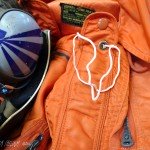 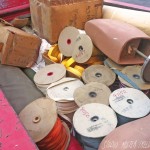
(end of fiction!)
The morphing of that made-up Team story into each garment of our “Sea Hunt” Collection spans an era of about 4 decades of influences and inspirational material, from several Continents and many latitudes.
It is not a dated ‘time capsule’, nothing was taken literally. History was speculated with. We keept it light 🙂
As a result, the general vibe of our Spring 2014 might partially qualify as:
* Vintage hi-tech
* Military sans war
* G.I. Joe Adventure Team gear
* Hatari! meets M*A*S*H in an unfashionable pho pas.
* The Calypso goes in-country
* Old-timey Survival and Tactical outfits
* Gym clothes for Astronauts
* Costumes for the 1966 Int’l Man of Action of the Year
* “Whaaaaat?”
* etc, etc… further descriptive left up to everyone’s imagination.
But, we are all pretty stoked about it around here. I dig this one. We hope some of you will too.
So, may the contenders for the 2014 Int’l Men of Action contest stay tuned… The word is about an imminent drop of Sea Hunt gear!
Thank you for reading my ramblings.
And thank you for your support, always.
cl
|





